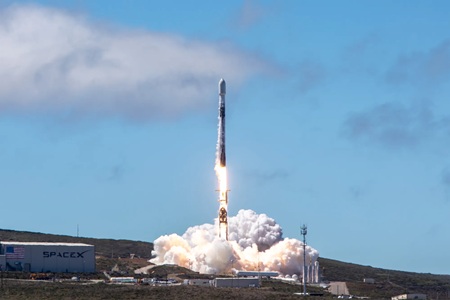NASA Launches TRACERS Mission Aboard SpaceX Falcon 9

NASA has successfully launched the TRACERS mission aboard a SpaceX Falcon 9 rocket from Vandenberg Space Force Base in California. The mission aims to explore Earth’s magnetic field interactions with solar activity, providing insights into space weather phenomena.
The twin TRACERS spacecraft, short for Tandem Reconnection and Cusp Electrodynamics Reconnaissance Satellites, will orbit near the North Pole to study magnetic reconnection events caused by solar wind collisions with the Earth’s magnetosphere. This research will help in understanding space weather dynamics and their effects on our planet.
TRACERS, a crucial mission in NASA’s heliophysics exploration, will collect detailed data over a 12-month period to analyze the dynamic processes occurring during magnetic explosions triggered by solar activity.
Acting NASA Administrator Sean Duffy expressed pride in the mission, highlighting its importance in advancing American expertise in space science. The project aims to decode space weather patterns and enhance understanding of the Earth-Sun connection, contributing to future lunar and Mars exploration efforts.
Ground controllers have established communication with the TRACERS spacecraft post-launch, initiating a phase to ensure the proper functioning of all systems. Once operational, the satellites will study the interaction of solar particles with Earth’s magnetic shield and their impact on near-Earth space.
David Miles, TRACERS Principal Investigator at the University of Iowa, praised the successful launch as a significant milestone towards unraveling Earth’s magnetosphere mysteries and studying space weather dynamics.
Alongside TRACERS, other NASA missions including Athena EPIC, PExT, and REAL were also launched. These missions focus on testing new technologies and gathering scientific data to advance space research.
Athena EPIC, led by NASA’s Langley Research Centre in collaboration with NOAA and the US Space Force, will showcase a flexible commercial satellite architecture and gather longwave radiation measurements. PExT aims to test a versatile polylingual terminal for enhanced space communications. REAL, a CubeSat from Dartmouth College, will study the scattering of energetic electrons from the Van Allen radiation belts into the atmosphere, improving knowledge about space hazards.
The TRACERS mission, managed by the University of Iowa and supported by academic institutions like the Southwest Research Institute, UCLA, and UC Berkeley, is a part of NASA’s Heliophysics Explorers Programme. The project was launched under NASA’s VADR contract, overseen by the Kennedy Space Centre.

